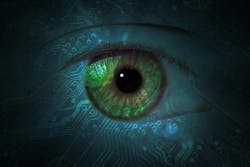Inspecting Liquids and Solids with Vision Systems
The use of vision systems for automated inspections has been growing for several years now and is expected to accelerate as part of the digital transformation of industry. Despite the increasing popularity of vision systems, many users still have questions about the technology and its proper use.
To help answer some of those questions, we connected with Fernando Callejon and Felix Klebe from Omron Automation for an episode of the “Automation World Gets Your Questions Answered” podcast series to explain not only what constitutes an industrial vision system, but how one is used to inspect liquids and solids on the production line.
Deriving from these components are four categories of industrial vision technology, Callejon said:
- Smart cameras—a combination of all the aforementioned vision system components into a single device;
- Vision systems—where image acquisition is separate from the vision processing controller;
- PC-based cameras—where the vision application software is installed on the user's PC or industrial PC connected to a camera via Ethernet; and
- Industrial cameras—which allow the user to visualize images with third-party software or with their own software application to inspect that image on a PC.
Explaining how to decide among the different vision technologies available for inspection applications, Callejon said to first consider the needs of the inspection application. “You need to clearly define what is an acceptable product and what isn't. So set clear judgment criteria, because you're going to use that when you're programming your devices.
Another important aspect to consider is: Will the inspected object be moving or stationary? Knowing this will help determine the type of image sensors you want to use. Also think about the space available to install the camera on the machine. Finally, consider the available budget, both in terms of hardware and service. This matters because, if you design the vision system entirely from components, you could save some of the integration and service costs. But you need to check if your team has the skills to work effectively with that kind of machine vision application.”
When it comes to inspecting either solids or liquids, Callejon said there is little difference from the hardware and software points of view. “The same vision system tools will be used, they’re just used in different ways. This is most evident with lighting. For example, a transparent liquid level inspection would normally use a backlight. While solid, opaque label inspections would use a more direct lighting approach.”
Motion also affects vision system choices in liquids and solids inspections. “For liquids, a smooth acceleration and constant speed or velocity will help to maintain level and consistent product separation,” Callejon said. “For solids, the maintenance of speeds is not as critical as it does not tend to change the characteristics of the item to be inspected.”
As with any automation technology, justifying the investment is always a critical step in the process. Callejon says the process for determining ROI (return on investment) from a vision system will likely differ depending on the industry. However, there are five common aspects to consider:
- Repeatability of inspection and consistent judgments;
- Speed of inspection to avoid bottlenecks on the manufacturing line;
- Net content control and waste management—this is key to maintaining labeled amounts to avoid penalties and waste;
- Labor costs—think about how you could repurpose inspection operators into higher-level, value-added activities once you have a vision system for inspection. This is particularly important today in light of COVID-19, as the use of vision systems can help reduce human contact; and
- Initial capital equipment costs and engineering costs.
About the Author
David Greenfield, editor in chief
Editor in Chief

Leaders relevant to this article:


